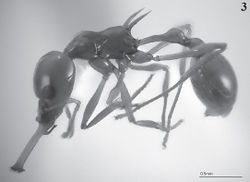Key to Acanthognathus Species
Key to Acanthognathus species based on workers and queens (modified by Galvis & Fernandez (2009) from Brown & Kempf (1969)).
1
- Dorsum of head smooth and shining, without any fossae or rugulose-punctulate sculpture => 2
- Dorsum of head sculptured, at least with numerous distinct round fossae on the disc, intervals smooth or rugulose => 3
2
- Mandibles longer than head in full-face view, each with two or three long spiniform teeth before the apex (Fig. 6); anterior part of head, especially in the region in front of the eyes with a few indistinct fossae; lower portions of sides of mesosoma and petiolar peduncle, in front and behind, minutely and densely punctulate => Acanthognathus teledectus
- Mandibles not longer than head in full-face view, preapical inner borders unarmed; body completely smooth and shining => Acanthognathus laevigatus
3
- Petiole with very long, slender peduncle, about three times as long as its node, which is short and transverse as seen from above => Acanthognathus stipulosus
- Petiolar peduncle slender, but less than twice as long as its node, which is oval and at least as long as broad as seen from above => 4
4
- Presence of transverse rugae on the posterior cephalic angles (fossil ant from Dominican amber) => Acanthognathus poinari
- Transverse rugae on the posterior cephalic angles absent => 5
5
- Antennal scapes short, chord less than 90% as long as mandibles seen in dorsal view; preapical area of inner mandibular border with (usually two or more) irregular denticles => Acanthognathus brevicornis
- Antennal scapes with chord about as long as, to much longer than, the mandibles as seen in dorsal view; inner mandibular borders without preapical denticles, though a submedian welt may be present => 6
6
- Mandibles shorter (MI 60-75); dorsum of head completely, densely, and rather finely rugulose, with interspersed fossae numerous, small, and crowded, so that the surface, including the area around the eyes, is essentially opaque => Acanthognathus rudis
- Mandibles longer (MI > 75); dorsum of head loosely sculptured and more or less shining, fossae large and shallow, with smooth spaces or simple longitudinal rugulae between some rows; at least a strip bordering each eye mesially nearly smooth, shining => 7
7
- Fossae on posterior half of dorsum of head smaller, mostly separated by flat, smooth spaces => Acanthognathus ocellatus
- Fossae on posterior half of dorsum or head large, mostly contiguous or separated by single, simple longitudinal rugulae => Acanthognathus lentus
References
- Brown, W. L., Jr.; Kempf, W. W. 1969. A revision of the neotropical dacetine ant genus Acanthognathus (Hymenoptera: Formicidae). Psyche (Camb.) 76: 87-109.
- Galvis, J. P. & Fernández, F. 2009. Ants of Colombia X. Acanthognathus with the description of a new species (Hymenoptera: Formicidae) Revista Colombiana de Entomología 35 (2): 245-249.











